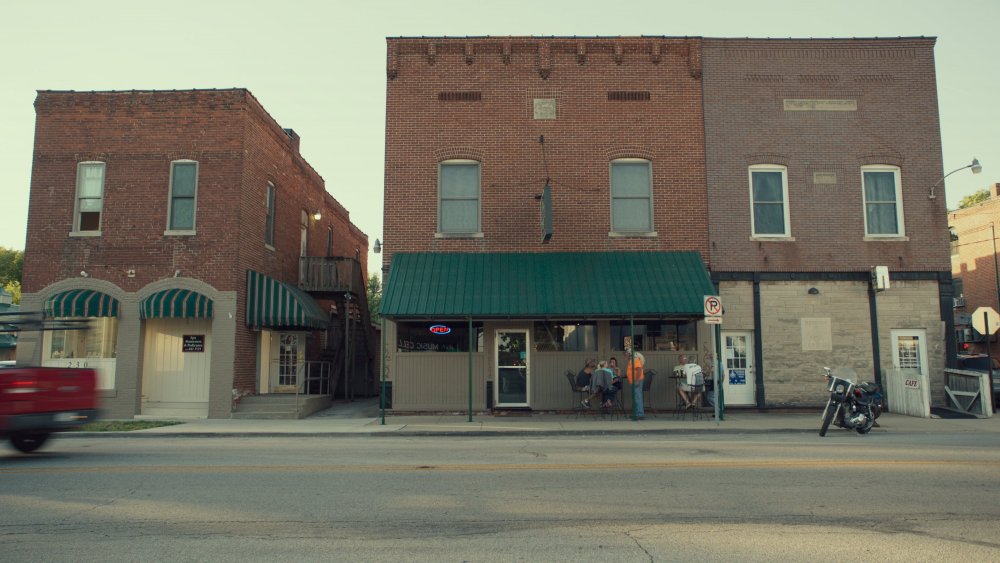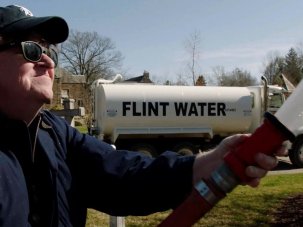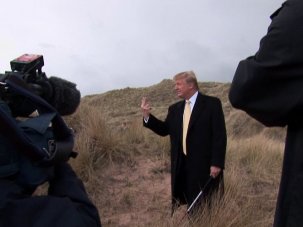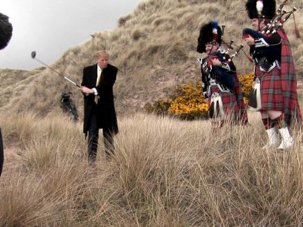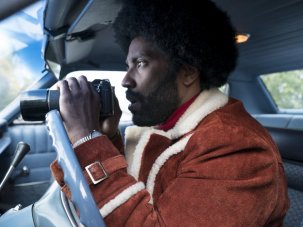With the US midterm elections looming, it’s been two years since the US electorate bestowed the Presidency on Donald Trump, along with handy Republican majorities in Congress. But it’s more than three years since the Trump train showed up, a travelling media circus that has upended traditional political discourse and dominated the conversation ever since.
Fahrenheit 11/9 is released in UK cinemas on 19 October. Monrovia, Indiana screens in the London Film Festival on 21 October 2018.
As I write, the New York Times nonfiction best seller list is topped by Tucker Carlson’s Ship of Fools, followed by Bob Woodward’s Fear and Michael Lewis’s The Fifth Risk, all books examining aspects of the Trump phenomenon (just a couple of spots further down: Good and Mad by Rebecca Traistor traces “The history and cultural significance of women’s anger”, followed by Stormy Daniels’ Full Disclosure, and at #8, Doris Kearns Goodwin’s Leadership).
So where are the movies of the Trump era? Give or take a BlacKkKlansman (or, better, Sorry to Bother You) the response to date has been muted. It typically takes years for a screenplay to gestate into a big-budget movie, so we might need to check back circa 2020 or later to find out how filmmakers process the spectacle of American fascism ascendant.
Documentaries are a different matter, and this season several of the genre’s most distinguished practitioners are addressing Trump, some head-on, others more obliquely. They include the blue-collar agitator Michael Moore, the most commercially successful nonfiction filmmaker of recent decades, whose new film Fahrenheit 11/9 is a treatise on the election night that surprised everyone – except Michael Moore. Then we have the more self-consciously interrogative, intellectual Errol Morris, whose American Dharma gives us an hour and a half inside the mind of one of the supposed architects of Trumpism, Breitbart boss and Trump campaign manager Steve Bannon. And one of the talismanic figures of the observational form, Fred Wiseman, weighs in with Monrovia, Indiana, a quiet study of a small bible belt community, the kind of place that swung Trump into office.
What You Gonna Do When the World’s on Fire?
(There are several more political documentaries worth noting: Robert Minervini’s lacerating What You Gonna Do When the World’s on Fire?, his black antonym to the shocking The Other Side; Dyana Winkler and Tina Brown’s infuriating United Skates, which finds a microcosm for the nation’s endemic racism and social breakdown in the decline of roller skating rinks; Alexis Bloom’s Divide and Conquer: The Story of Roger Ailes; Charles Ferguson’s mammoth, piquantly titled Watergate: How We Learned to Stop an Out-of-Control President.)
Given this administration’s all-round assault on liberalism (towards the environment, education, civil liberties, immigration, consumer protection, healthcare, public broadcasting and the arts, the list goes on and on), it would be surprising if independent filmmakers didn’t consider themselves cast in opposition. But for documentary filmmakers there is a more fundamental and compelling need to respond to Trump. This President and his administration have been waging a War on Truth ever since the inauguration, when Kellyanne Conway coined the infamous phrase “alternative facts”.
For decades, nonfiction filmmakers have concerned themselves with the ethics and responsibilities of mediating reality, a process that has led to many a disclaimer, if not outright disavowal. Now comes Trump, making a mockery of these fine distinctions, wrapping himself in a post-modern ‘post-truth’ discourse of ‘Fake News’. “Just remember: what you are seeing and what you are reading is not what’s happening,” the President instructed supporters earlier this summer. “Truth isn’t truth,” chimed Rudy Giuliani at much the same time.
This Orwellian doublespeak seems designed not only to deny and deflect inconvenient aspersions on the dubious character of the President and his politics, but to undermine any semblance of empirical truth. As 1984 illustrates, the eradication of meaning is tantamount to the dissolution of the republic, the erasure of free will. Simply put, if we can’t trust our own eyes, we’re finished.
What role then, for the citizen filmmaker? Probably there has never been a more pressing need for their work, and Wiseman, Morris and Moore have responded with three distinctive and engaged films.
Fahrenheit 11/9 (2018)
Moore (64) certainly assumes a sense of urgency. Fahrenheit 11/9 has been rush-released with the avowed aim of influencing the midterms in November (though its US box office returns have been disappointing). A polemist and a pragmatist, Moore has always put his politics first, and as in the past he plays both the jester and the journalist here, using ridicule and satire to land serious points about television’s infatuation with candidate Trump (which earned him saturation coverage well before he was the Republican nominee). But the shtick feels old hat: cable news commentators like Stephen Colbert and Rachel Maddow have assumed Moore’s mantle and lampoon Trump on a nightly basis.
When he started making films nearly 30 years ago Moore’s brand of populist agitprop was an outlier, a revitalising antidote to the staid conventions of establishment media, but as the middle-ground consensus has shrunk and cable news has gravitated towards tribalism and rabble-rousing (the subject of Divide and Conquer) satire seems incapable of reaching the unconverted. Outrage itself feels like debased currency in this era of impunity.
It’s Moore’s credibility as a reporter on the frontline of his economically distressed hometown, Flint, Michigan, which is most valuable. The strongest material in the new Fahrenheit concerns the toxic water contamination that poisoned the predominantly African American citizenry for years, despite assurances to the contrary from elected officials up to and including President Obama. Moore’s overriding contention that the Democratic Party has betrayed its base and sold itself to lobbyists may not be new, but it’s honest and heartfelt. It stings.
A clip from Fahrenheit 11/9
In an odd but telling coincidence, in Fahrenheit 11/9 and American Dharma, Moore and Errol Morris both cite Steve Bannon’s admiration for their filmmaking. They are not going to win any prizes at Cannes but it’s not too hard to make out the broad outlines of Moore’s formal influence on the propaganda pieces Bannon has produced and/or directed, including In the Face of Evil: Reagan’s War in Word and Deed (2004), Battle for America (2010) and Clinton Cash (2016).
If Moore is bemused by Bannon’s flattery, Morris seems more perturbed. American Dharma can be placed at the head of a trilogy of portraits of powerful men Morris has interviewed, starting with Robert McNamara in The Fog of War (the 2003 film that Bannon likes so much), and proceeding with Donald Rumsfeld in The Unknown Known (2013).
All three films have courted controversy from spectators unwilling to entertain voices from the other side, and American Dharma has yet to find a US distributor, no matter that Bannon’s noxious views and racism prompt Morris to take a more combative interviewing approach than he has in the past.

American Dharma (2018)
He puts aside his patented ‘Interrotron’ camera here and places Bannon in a Quonset hut, a military briefing room in the style of Twelve O’Clock High, one of several movies (The Bridge on the River Kwai is another) that Bannon cites as inspiration for his nativist convictions. This set plays into Bannon’s image of himself as a Machiavellian backroom general fighting for the soul of America in a Culture War the liberals just don’t want to face up to, but it’s clearly an ironic gesture on Morris’s part, a signal that this tinpot intellectual’s worldview belongs to the past and can only end in flames.
What’s most arresting about American Dharma is how popular mid-20th century movies – The Searchers, My Darling Clementine, The Man Who Shot Liberty Valance all weave their way through this narrative – have become so entwined in conservative thought, yet in a reductive, distorted form that robs them of their complexity and beauty. The ‘Great America’ Steve Bannon harks back to becomes a weird amalgam of the Eisenhower era and John Ford’s frontier outposts, a psychic homeland under constant siege from imaginary threats.
Like Michael Moore, Bannon speaks of (and for) a working class that has no work, feels itself disenfranchised and more than anything fears dispossession. For Bannon, this working class is also white, Protestant, and soon to become a minority. (When Bannon denies this characterisation of his beliefs, Morris inserts Breitbart headlines that spell them out quite clearly.)
These are much the same folks who feature in Fred Wiseman’s Monrovia, Indiana. A portrait of a typical Midwestern farming town (population: 1,400), the film is in some respects Wiseman’s version of one of those ‘Meet the Trump voters’ pieces that pop up regularly in the New York Times and the Guardian, except that the name ‘Trump’ never once comes up – he is too subtle and nuanced a reporter for that.
At 88, Wiseman has lived through the Depression, WWII, the civil rights era, Vietnam, Watergate and the two Iraq wars, but the public institutions – the hospitals, bureaucracies, places of learning and edification – which he has faithfully recorded throughout his 50-year career can only hope to survive this administration by virtue of its own incompetence. As Wiseman acknowledged on the release of his last film, Ex Libris – The New York Public Library (2017), the election of Donald Trump retroactively rendered it a more acutely political work, simply because the liberal humanism that underpins such an organisation is an affront to the greed, ignorance and narcissism which constitutes Trumpism.

Monrovia, Indiana (2018)
Wiseman’s immersion in farm country is as reserved and unforced as his forays into the National Gallery and Berkeley. He pays his subjects and his audience the compliment of patience: we see the town council meet with state planners, hair being cut, county fairs, guns being purchased, wedding vows being exchanged… There is a long scene in which a vet docks a dog; a longer one at an emptily observed Masonic ceremony.
The film is scrupulously neutral in tone, even banal, but it’s hard not to see certain ironies in the counterpoint between the community’s religious values and scenes at the gun store or the tattoo parlour, even without the incursion of the Hell’s Angels. The council’s debate about the social problems that come with increased development (a new residential district graced with the name ‘Heartland’ demands greater infrastructure) also reminds us that Monrovia – and other towns like it – are on the verge of atrophy. If they don’t expand they will wither into nothing.
Rather than pressing overt political interpretations on his anthropological research, Wiseman implies that such a fate is likely inevitable. There is a sense of isolation and mortality creeping through the film, which culminates in its most prolonged single sequence, a funeral oration that becomes a very moving eulogy not only for the deceased, but for the idea of community and the spiritual faith that sustains it through good times and bad.
Monrovia, Indiana trailer
-
The Digital Edition and Archive quick link
Log in here to your digital edition and archive subscription, take a look at the packages on offer and buy a subscription.




